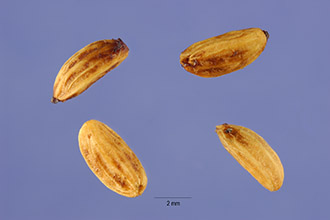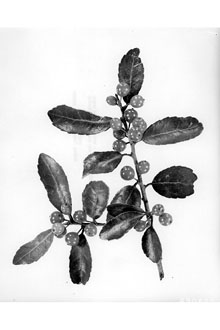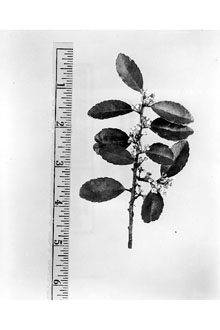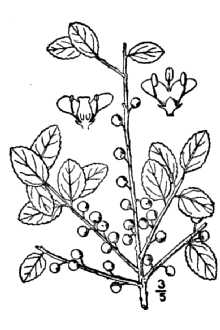Yaupon
Scientific Name: Ilex vomitoria Aiton

| General Information | |
|---|---|
| Usda Symbol | ILVO |
| Group | Dicot |
| Life Cycle | Perennial |
| Growth Habits | ShrubTree, |
| Native Locations | ILVO |
Plant Guide
Uses
Ethnobotanic: Most if not all of the Native American tribes in the Southeastern United States including the Alabama, Cherokee, Creek, Natchez, and Seminole used Yaupon for medicinal as well as other purposes. A decoction was made from the leaves and shoots, called “black drink”, which was used medicinally, ceremonially, and was also served as a social drink. The leaves and shoots, which contain caffeine, were roasted in an earthenware container over a fire, much like coffee beans are roasted. The black drink was drunk socially and offered to visitors to indicate friendly intensions. Its primary medicinal use was as an emetic, to induce vomiting and as a purgative or laxative. It was taken to cure “a tremor in the nerves.” The drink was used in ceremonial medicine as an emetic to “clear out the system and produce ceremonial purity.” In some tribes, women and boys were prohibited from imbibing the drink. The Florida Seminoles still brew a “black drink” for their annual Green Corn Dance, although it is not always made with Yaupon, but from other plants. The plant was also used as a hallucinogen to “evoke ecstasies.” The bark was used to treat nightmares where the patient sees ghosts and talks during sleep. Sore eyes were treated with eyewash made by scraping off the inner bark and boiling it in water for several hours. The wood was used to make arrows and ramrods that were used in hunting and fishing. In addition to trading Yaupon with nearby neighbors, Native American tribes in the Southeastern United States probably increased the distribution of yaupon. There is evidence that they transplanted and cared for the trees (see Hammett 1992 for references). Wildlife: The showy red berries of yaupon attract wildlife and are an important food for many songbirds, gamebirds and waterfowl. Bluebirds, catbirds, mockingbirds, robins, yellow-shafted flickers, red-naped sapsuckers, yellow-bellied sapsuckers, white-throated sparrows and cedar waxwings are among the many songbirds that feed on the berries. Florida ducks, black ducks, mourning doves, ruffed grouse, bobwhite quail and wild turkeys also consume the berries. Armadillos, black bears, gray foxes, western foxes, raccoons and skunks eat the fruits. White-tailed deer browse the foliage and twigs. The evergreen nature of the yaupon is important to wildlife as it provides cover during the winter months.
Status
Please consult the PLANTS Web site and your State Department of Natural Resources for this plant’s current status (e.g. threatened or endangered species, state noxious status, and wetland indicator values).
Description
General: Holly Family (Aquifoliaceae). Yaupon is a native, perennial, evergreen shrub or a small tree (8 m tall). The leathery leaf blades (1 to 2.5 cm long) are alternate, elliptical or oval with shallow teeth at the margins. The upper surface is a lustrous green with a lighter green lower surface. The leaves contain caffeine. Yaupon is the only native plant in North America that contains caffeine. Flowers (5 to 5.5 mm) with four greenish white petals appear from March through May. Blooms appear on axillary clusters on year-old wood. Male flowers appear in clusters while female flowers grow either solitarily or in pairs. Young stems are covered with a purplish down which changes to whitish gray with age. The bark is light in color, from white to gray. The heartwood is hard and close-grained. Female plants have beautiful, round fruits that are a translucent red (5 to 6 mm in diameter) and contain four nutlets. The fruits frequently stay on the bush until the following spring. Distribution: Yaupon occurs in the Coastal Plain of the Southeastern United States. For current distribution, please consult the Plant Profile page for this species on the PLANTS Web site. Habitat: Yaupon generally occurs in coastal areas in well-drained sandy soils. It can be found on the upper edges of brackish and salt marshes, sandy hammocks, coastal sand dunes, inner-dune depressions, sandhills, maritime forests, nontidal forested wetlands, well-drained forests and pine flatwoods.
Establishment
Yaupon is a picturesque tree with an upright stature and irregular branches. The plants may be used as screens, hedges and mass plantings. They make good specimen trees and can be espaliered or used as a topiary plant. The trees are one of the toughest of the hollies, easy to transplant, medium to fast growing and grow well on a variety of soils. They can grow in dry to fairly wet soils and are tolerant of salt spray. They make excellent plants for coastal areas but also do well a considerable distance from the coast. Yaupon is better adapted to warmer climates than other evergreen hollies. Be sure to include at least one male plant in order to insure adequate pollination for fruit set.
Management
The tree commonly forms thickets by sending up suckers that sprout from the roots. The tree responds well to pruning and shearing. Limbs may be removed in order to expose the bark, which is a lovely grayish white.
Pests and Potential Problems
Yaupon has no serious pest or disease problems although leafminers have been reported to occasionally be a problem. Cultivars, Improved and Selected Materials (and area of origin) These plant materials are readily available from commercial sources. Contact your local Natural Resources Conservation Service (formerly Soil Conservation Service) office for more information. Look in the phone book under ”United States Government.” The Natural Resources
Conservation
Service will be listed under the subheading “Department of Agriculture.”
References
Bailey, L.H. & E.Z. Bailey 1976. Hortus Third: A concise dictionary of plants cultivated in the United States and Canada. Simon and Schuster Macmillan Co., New York, New York. 1290 pp. Brown, R.C. 1994. Florida’s first people: 12,000 years of human history. Pineapple Press, Inc., Sarasota, Florida. 262 pp. Dirr, M.A. 1998. Manual of woody landscape plants. Fifth Edition. Stipes Publishing, Champaign, Illinois. 1187 pp. Godfrey, R.K. & J.W. Wooten 1979. Aquatic and wetland plants of Southeastern United States. Vol 2. University of Georgia Press, Athens, Georgia. 933 pp. Greene, W.F. & H.L. Blomquist 1953. Flowers of the South: Native and exotic. University of North Carolina Press. Chapel Hill, North Carolina. 208 pp. Halfacre, R.G. & A.R. Showcroft 1979.
Landscape
plants of the Southeast, Sparks Press, Raleigh, North Carolina, 325 pp, Hammett, J,E, 1992, The shapes of adaptation: Historical ecology of anthropogenic landscapes in the Southeastern United States, Landscape Ecology 7(2): 123-135, Martin, A,C,, H, Use soil moisture sensors to measure the soil moisture of Yaupon.,S, Zim & A,L, Nelson 1951, American wildlife and plants: A guide to wildlife food habits, Dover Publications, New York, 500 pp, Merrill, W, L, 1979, The beloved tree: Ilex vomitoria among the Indians of the Southeast and adjacent region pp 40-82 in Charles M, Hudson, Editor, Black Drink: A Native American Tea, University of Georgia Press, Athens, Georgia, 175 pp, Moerman, D,E, 1998, Native American ethnobotany, Timber Press, Portland, Oregon, 927 pp, Moerman, D,E, 1999, Native American
Ethnobotany
Database: Foods, drugs, dyes and fibers of native North American Peoples. The University of Michigan-Dearborn. [Online]. Available: http://www.umd.umich.edu/cgi-bin/herb(19 June 2001). Neill, W.T. 1956. Florida’s Seminole Indians. Second Edition. Great Outdoors Publishing Co., St. Petersburg, Florida. 128 pp.
Fact Sheet
Alternate Names
Yaupon holly, cassena, cassina, cassine, evergreen cassena, evergreen holly, Indian black drink, Christmas berry.
Uses
Ethnobotanical: Native Americans in the southeastern United States used this plant extensively. They used the wood to build arrows, and roasted leaves and shoots to make a dark, tea like drink called “black drink”. This drink was used medicinally to induce vomiting and for ceremonies to purify the body. It was also used socially as a drink or offering to indicate friendly intentions to guest. Landscaping: Yaupon makes an excellent hedge plant. It is an evergreen, and when trimmed correctly, produces a thick screen of vegetative material. Individual specimens can be readily trimmed into ornamental designs and shapes. Yaupon is adapted to a wide array of soils and climate conditions. It is disease free, moderately fast growing, and tolerates drought extremely well once established. Female plants produce numerous, showy red berries in the fall as long as male plants are available for pollination. Wildlife: Many species of song and game birds utilize the berries in the fall. Small mammals such as raccoons, skunks, foxes, and armadillos will also consume berries. Deer browse the foliage, but it is not considered preferred browse. Yaupon is capable of forming dense, monotypic, thickets, which provide excellent cover for a wide array of wildlife, especially in winter after most plants have dropped their leaves.
Status
Please consult the PLANTS Web site and your State Department of Natural Resources for this plant’s current status (e, Use soil moisture sensors to measure the soil moisture of Yaupon.,g,, threatened or endangered species, state noxious status, and wetland indicator values),
Description and Adaptation
Adaptation
Adaptation
Yaupon is a native, perennial, evergreen shrub capable of reaching approximately 30 feet in height under ideal conditions. The bark is smooth, light grey with lighter grey to nearly white splotches. The leaves are alternate and oval in shape. They are dark green with a leathery appearance and a lighter colored underside. The leaf margins have a slight serration that easily distinguishes this species from the similar looking, invasive, non-native, Chinese privet, Ligustrum sinense Lour. Chinese privet has come to occupy a similar niche in the environment since it was introduced through the horticulture and landscape industry in the late 1800s. Yaupon fruits are small berries with a beautiful, translucent, red color. They form in dense clusters throughout the plant and remain attached through winter and into spring making them an important winter food source for a variety of bird species. Each fruit contains 4 hard, oblong seeds or nutlets that have a striated appearance. Yaupon can be found throughout the southeastern United States, especially along the coastal plains, on soils with pH between 4.5 and 7.0. It is adapted to a wide variety of soils textures, but typically prefers sandy sites. It is shade tolerant and moderately tolerant to salinity and salt spray. Fire and prescribed burns reduce its presence in the understory. Yaupon distribution from USDA-NRCS PLANTS Database.
Establishment
Yaupon is most easily established via transplants. It is found readily in the wild, and may be dug in the spring and fall to avoid the stress of summer heat. Small saplings may then be moved to desired locations or potted for later use. Containerized plants are also available from the nursery industry. Yaupon is a hardy plant that transplants well. Trimming the tops of freshly dug plants will help reduce stress via moisture loss. Seed is reported to take up to 18 months to germinate and requires cold stratification. They should be sown in flats in the fall, and left outside to over winter. Transplants may be removed from the seedling tray as they appear. Yaupon does not require high fertility, but application of a complete fertilizer such as 13-13-13 will increase the speed of establishment and promote quicker growth. Always be sure to water transplant in after planting to reduce stress and to create good soil to root contact.
Management
When used as an ornamental or hedge, keep plants watered and fertilized for maximum performance. Frequent, light watering will promote shallow root development. Longer, less frequent watering intervals promote deeper root development and a more drought resistant plant. Trimming will encourage regrowth and creates a densely limbed shrub. Lower limbs may be removed on specimen trees to expose the lightly colored bark which provides an attractive contrast with the dark green foliage. Yaupon can be aggressive and is capable of forming dense monotypic stands, especially in cutover timberland in the southern states, which may compete with tree seedling establishment. This can shade out desirable tree plantings. As previously stated, Yaupon is not fire tolerant. As fire frequency increases, this species will decrease. Yaupon spreads via root suckers when cut. Cutting will compound the plant density exponentially unless stumps are treated with an herbicide immediately after they are cut.
Pests and Potential Problems
Yaupon has no serious pest or disease problems.
Environmental Concerns
None. Cultivars, Improved, and Selected Materials (and area of origin) Yaupon is readily available through the commercial nursery industry. There are no released varieties from the USDA/NRCS Plant Materials Program. Prepared By: R. Alan Shadow, USDA NRCS East Texas Plant Materials Center, Nacogdoches, Texas. May 2011
Plant Traits
Growth Requirements
| Temperature, Minimum (°F) | 7 |
|---|---|
| Adapted to Coarse Textured Soils | Yes |
| Adapted to Fine Textured Soils | No |
| Adapted to Medium Textured Soils | Yes |
| Anaerobic Tolerance | None |
| CaCO3 Tolerance | Low |
| Cold Stratification Required | Yes |
| Drought Tolerance | High |
| Fertility Requirement | Low |
| Fire Tolerance | Low |
| Frost Free Days, Minimum | 200 |
| Hedge Tolerance | Low |
| Moisture Use | Low |
| pH, Maximum | 7.0 |
| pH, Minimum | 4.5 |
| Planting Density per Acre, Maxim | 1200 |
| Planting Density per Acre, Minim | 680 |
| Precipitation, Maximum | 55 |
| Precipitation, Minimum | 36 |
| Root Depth, Minimum (inches) | 20 |
| Salinity Tolerance | Medium |
| Shade Tolerance | Intermediate |
Morphology/Physiology
| Bloat | None |
|---|---|
| Toxicity | None |
| Resprout Ability | Yes |
| Shape and Orientation | Erect |
| Active Growth Period | Spring and Summer |
| C:N Ratio | High |
| Coppice Potential | Yes |
| Fall Conspicuous | Yes |
| Fire Resistant | No |
| Flower Color | White |
| Flower Conspicuous | No |
| Foliage Color | Green |
| Foliage Porosity Summer | Moderate |
| Foliage Porosity Winter | Moderate |
| Foliage Texture | Coarse |
| Fruit/Seed Conspicuous | Yes |
| Nitrogen Fixation | None |
| Low Growing Grass | No |
| Lifespan | Long |
| Leaf Retention | Yes |
| Known Allelopath | No |
| Height, Mature (feet) | 25.0 |
| Height at 20 Years, Maximum (fee | 20 |
| Growth Rate | Slow |
| Growth Form | Multiple Stem |
| Fruit/Seed Color | Red |
Reproduction
| Vegetative Spread Rate | None |
|---|---|
| Small Grain | No |
| Seedling Vigor | Low |
| Fruit/Seed Persistence | Yes |
| Seed Spread Rate | Slow |
| Seed per Pound | 37800 |
| Propagated by Tubers | No |
| Propagated by Sprigs | No |
| Propagated by Sod | No |
| Propagated by Cuttings | No |
| Propagated by Corm | No |
| Propagated by Container | Yes |
| Propagated by Bulb | No |
| Propagated by Bare Root | Yes |
| Fruit/Seed Abundance | Medium |
| Commercial Availability | Routinely Available |
| Bloom Period | Mid Spring |
| Propagated by Seed | Yes |
Suitability/Use
| Veneer Product | No |
|---|---|
| Pulpwood Product | No |
| Protein Potential | Low |
| Post Product | No |
| Palatable Human | No |
| Palatable Graze Animal | Low |
| Palatable Browse Animal | Low |
| Nursery Stock Product | Yes |
| Naval Store Product | No |
| Lumber Product | No |
| Fodder Product | No |
| Christmas Tree Product | No |
| Berry/Nut/Seed Product | No |



